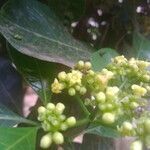Leaves 3–14(20) x 1–6(10) cm., narrowly obovate to oblanceolate or oblong-elliptic, rounded to acuminate at the apex, narrowly cuneate at the base, rather thin to subcoriaceous or coriaceous; domatia often present in nerve-axils with ± small openings; petiole 0.4–2(4) cm. long; stipules 3–8 mm. long, triangular to ovate-triangular, apiculate to acute at the apex, glabrous or rarely pubescent, soon falling.
A shrub or small tree. It grows 1-5 m tall or taller. The stems are finely ridged. The leaves are 3-14 cm long by 1-6 cm wide. The flowers are in much branched groups 2-15 cm long. They are yellow. The fruit are red and 5-6.5 mm across.
Shrub or small tree to 7 m. Leaves opposite, leathery, obovate, margins revolute. Flowers in terminal, pedunculate cymes. Flowers yellow, berries red.
Flowers in much-branched panicles 2–15 cm. long; peduncle 1–10 cm. long; pedicels 0–2 mm. long to 5–12 mm. in fruit; bracts and bracteoles minute.
Shrub or small tree 1–5(20) m. tall with pale finely ridged stems, mostly glabrous but with pubescent foliage inflorescences etc. in one variety.
Corolla cream or yellow; tube (2)3–5 mm. long; lobes 1.5–3 x 1.3–2 mm., oblong-triangular, ± thickened at the apex.
Stamens with filaments 1.5–3.5 mm. long in short-styled flowers and 0.3–1 mm. long in long-styled flowers.
Calyx tube and limb tube together scarcely 1–1.5 mm. long; lobes 0.3–0.5 mm. long, triangular.
Style 2–3 mm. long and 4.5–5 mm. long respectively, the stigmatic arms 0.5–1 mm. long.
Fruits red, ± 5–6.5 mm. diam., subglobose; pyrene with abaxial face entire.
Seed with adaxial face flat and deeply ruminate, abaxial face convex.


